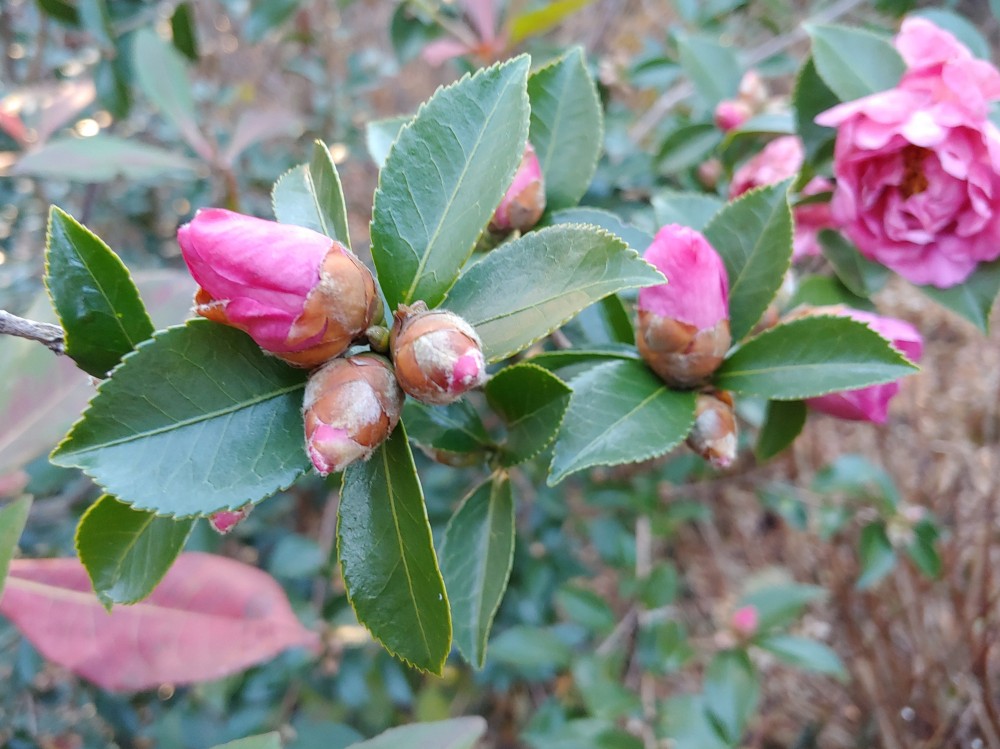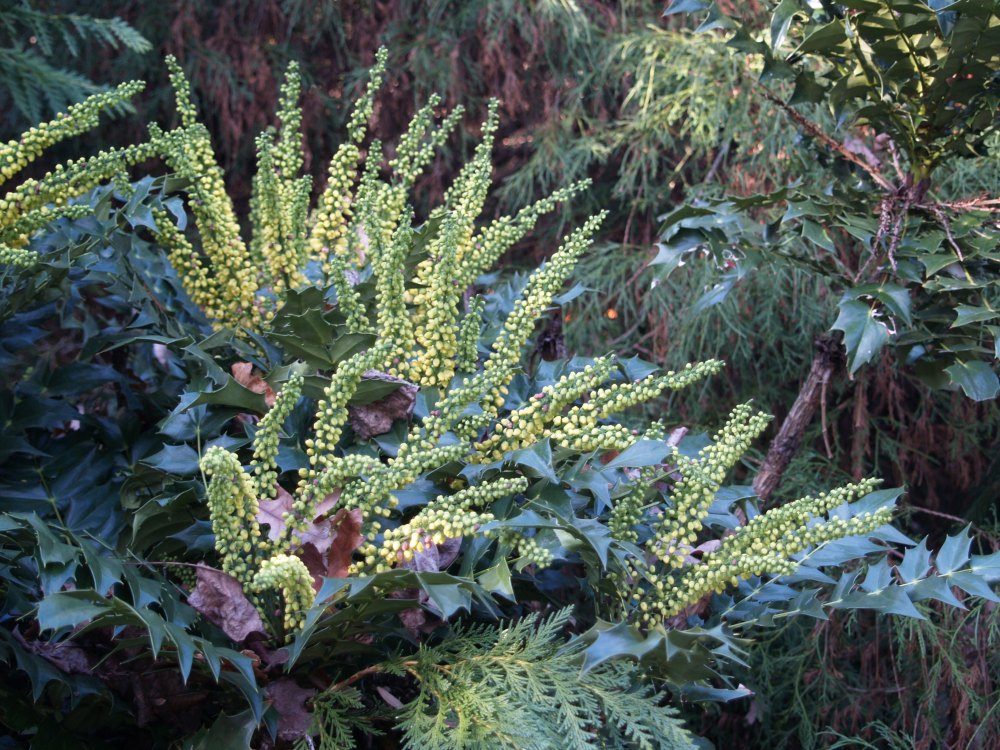Autumn flowering, hybrid mahonias (Mahonia x media) are a bit late, usually beginning bloom in mid-November, but today showing only yellow through the buds on elongated panicles. I expect buds to open soon, in a few days, but it could be another week. With late autumn flowering, I’m uncertain if it’s cold, heat, or hours of sunlight that influence the timing of flowers. The weather forecast for the next week includes a bit of everything, from twenty to sixty-five degrees, snow and probably short sleeves, but whatever, there should be flowers soon. In any case, once flowering begins, flowering will persist for six weeks or longer unless temperatures drop below ten degrees (F.).
The oldest of the garden’s hybrid mahonias are ‘Winter Sun’ (ten years or longer), with more recent plantings (in the past five years) of ‘Charity’, ‘Underway’, and ‘Marvel’ that are mostly indistinguishable except that ‘Marvel’ has only a single spine at the tip of each leaf. Two ‘Marvel’, most recently planted a year ago, show no signs of imminent flowering, one perhaps the result of excessively damp soil and the other could be too shaded.
Several Leatherleaf mahonias (Mahonia bealei, above) flower in early spring, and already panicles are developing. Occasionally, in a very mild early winter, these will bloom as early as mid-January, and a time or two flowers of autumn and spring bloomers have intersected for a week or two. Another mahonia (‘Beijing Beauty’) flowers unremarkably, with short panicles partially obscured by foliage earlier in autumn, and ‘Soft Caress’ and a few others have proven not to be sufficiently cold hardy.
A year ago, autumn flowering camellias were exceptional early in the season, the best that I can recall, with scattered blooms extending into December. The timing of flowers is later, and more typical this year, and despite regular nighttime temperatures into the twenties new buds open daily (above). Fully opened flowers are damaged by temperatures in the low twenties, so each shrub displays white or pink as well as partially browned flowers. As long as daytime temperatures rise above forty degrees buds will continue to open into January.

What wonderful pictures as always Dave! Love the camellias! Have a good weekend and hope your Thanksgiving was lovely…:)
Did you already show pictures of the Mahonia X media? I have been seeing a bit of it online. It seems to be more popular elsewhere than I would have guessed. I do not know why it is not more popular here, perhaps because it is identified with Eichler architecture. A few of the mahonias were popular with those homes, and got a bad reputation for their overuse. However, the Oregon grape is more popular than it should be. It does not often look very good here, and is certainly not as happy here as the others are.
I rarely see the Oregon grape (Mahonia aquifolium) in area landscapes, and I do not grow this one, even though it is cold hardy. Too often, I noticed foliage on Oregon grape with brown edges that made it unattractive. The main attraction for mahonias in this garden is early and late winter flowers, which are otherwise very limited. Leaves are damaged when temperatures drop below zero, but mahonias typically recover quickly. Also, it’s helpful that the spiny leaves are very deer resistant.
Deer resistance might be one of the main attributes in suburban landscaping. I do not understand what the allure is in rural areas. Although they can look very good in our mild climate, ‘gardeners’ do not allow them to. Mahonias, like Heavenly bamboo, gets shorn and deprived of its natural form and texture.
Oregon grape and leatherleaf (M. bealei) are ramblers, while the autumn flowering hybrids have an upright habit. A few Winter Sun are now too tall to see many blooms, so these could be cut down to size someday, but pruners aren’t put to use much in this garden.
Mahonia lomariifolium is one of the raddest but also one that is almost always ruined by ‘gardeners’. It can be allowed to get quite tall with lower growth thinned out to expose the trunks, but only if a few of the new stems remain to be ready to replace the old trunks when they finally get so old that they need to be pruned out. I do not think I would put that much effort into it. It was also one of the more popular with Eichler architecture.